Travelers often pronounce that Cuba is a country like no other. However, there seems to exist a split view about travel experiences in the country. Some commend how the country is still warped in time and exudes a sincere charm. Others condemn how the country is a rendition of poverty and a cry for modern development. So, what actually lies beyond the classic cars and the iconic buildings? It was the first time we were traveling to Cuba. As the plane prepared for landing, I kept contemplating what to expect from our first trip to Cuba? How will be my interaction with this unique country? Will the reality of Cuba be able to live up to our expectations?
Every moment of our Cuba trip, we realized that it is essential to prepare yourself for traveling to this special country. Here is a compilation of all the factors you should take into account for your first ever trip to Cuba.
Communism and history
Cuba is the land of Fidel Castro. <goosebumps>
Brief introduction: In 1953, communist revolutionary Fidel Castro started an armed revolution that eventually toppled the dictatorship government of the then Cuban President Fulgencio Batista in 1959. Revolutionaries Ché Guevara and Camilo Cienfuegos were two other major figures, among others, who contributed to this triumph of Cuban Revolution. After this historic win, Fidel Castro formed his government and became the Prime Minister of Cuba. Following the Marxist-Leninist model, he converted Cuba into a one-party socialist state under communist rule. Castro made several political, military, economic and social reforms that transformed the country forever. However, this caused huge repercussions from the western world – United States of America, in particular. Thus began a series of conflicts starting from suspension of all diplomatic ties between Cuba and United States, the effects of which last even to this day! In fact, Americans of Cuban origin even have had to wait for years before they could visit their home country.
Before you travel to Cuba, it is extremely important to get an understanding of at least this bit about the country. If you can familiarize yourself with the country’s political and historical situation, you will probably find many other details about Cuba explicable. So if you are not already acquainted with Cuba’s past (and present), I suggest you pick up a book or two on the topic before you book that plane ticket to Cuba.

Our personal note: Communism and Kolkata – the Bengali perspective
Both the husband and I were born and raised in Kolkata, the capital city of West Bengal state in India. Left Front, an alliance among communist parties like Communist Party of India (Marxist), Communist Party of India etc. formed the state government of West Bengal from 1977 till 2011. That is a period of 34 long years, which started well before our births and continued till after we left Kolkata to pursue our careers.
Needless to say, we were heavily exposed to how communism works – both its benefits and its limitations. I am not here to talk about my political preferences. That is a much deeper conversation I will reserve for when we meet in person over a beer or some coffee! But I think it may be interesting for you to know the kind of influence communism had had over us, particularly during our formative years.
Like many others from my city Kolkata, much of our youth was shaped by communist ideologies from all over the world – from Karl Marx to Fidel Castro (yes, Fidel Castro from Cuba!). And whether one supports communism or not, every Bengali considers Che Guevara an icon to idolize. Just walk around the streets of Kolkata, you will be surprised to see the number of Che Guevara t-shirts hanging on people or at shops. (By the way, that is why we did not buy any Che Guevara t-shirt from Cuba.) Most Bengali young adults mark The Motorcycle Diaries as a movie to definitely watch and re-watch.
So, you can imagine the kind of exhilaration that gushed through our minds when we landed in Cuba for the first time! Now can you relate to the goosebumps I mentioned at the beginning of this section?

Internet challenges in Cuba
Cuba practices internet censorship by systematically limiting infrastructure for cheap access to internet. What does it mean for you as a tourist?
Can you access internet everywhere?
- The hotel/ home-stay you booked will not have WiFi connection. (Do not fret)
- Even if they do have WiFi router, you will not be able to access the internet. (No, no – do not fret)
- You need to buy an internet card – it is a scratch card to get a password which can be used to access the WiFi hotpots. (See, I told you not to fret!)
- You can use the internet card to access internet only at designated public WiFi hotspot areas or at some selective cafes/ restaurants/ hotels that have WiFi router. (Why are you still fretting? You did buy the internet card – you just need to find a spot where you can use it)
Internet card: What, how much, where?
- The most common internet card provider is ETECSA. Cost: $1 for a 1-hour card. (Expensive for something as regular as internet, but you can afford it, right? Cuban people have to spend the same $1 where their average monthly wage ranges between $25-$30! Given this, is your fret on the $1 internet access really worth it?)
- You can buy the internet card directly from ETECSA counters for the best price. Just that, you may need to wait for about 30 mins to 1 hour in a queue just to enter the shop! (Ok, I understand – you can fret a little!)
While we are on the topic of staying connected digitally, you may also want to check if you need an electricity adapter in Cuba for your devices.
Alternative ways
Did you choose not to stand in the queue? Did you forget to buy the internet card before the ETECSA shop closed at 7pm? You can still buy a card from indirect sellers at different shops or agents hanging after hours around the designated hotspot areas at 200% of the actual price. Okay, that sounds harsher than it actually is – for the traveler, not for the local. These indirect sellers charge you $2 for the $1 1-hour internet cards. A price you can pay if you are desperately in need of internet, right?
If all of this is too much hassle for you, how about an internet free vacation? Isn’t that something you always talk about but have never actually done?
Warning: When you actually get away from the internet, the public hotspot parks may appear weird to you. You will notice a cluster of human beings with their necks hung low and their eyes fixed on a flared 5 inches screen. Sounds familiar, eh?

Currency concept of Cuba
Cuba has a somewhat complicated dual currency system. In addition to its existing currency, Cuba introduced the second currency in 1994 as a measure to boost its weak economy.
Cuban Peso (CUP) is the currency used by locals to buy and sell of all regular commodity. It stands at an exchange rate of approximately 1 USD = 26 CUP.
Cuban Convertible Peso (CUC) is the newer currency. It is supposed to be used in the tourism industry and for purchase of luxury goods. This currency is the equivalent of U.S Dollar, that is, 1 USD = 1 CUC.
CUC is the only currency you will need for your travels in Cuba.
Points to note
- Cash is king. Very few places accept card payments.
- American credit cards/ debit cards do not work in Cuba.
- USD may have 1:1 conversion with CUC, but Cuba charges a 10% surcharge on all dollar exchange, buy or sell.
- Carry your money in Canadian Dollars/ Euros/ Mexican Pesos for currency exchange. Not U.S dollars, because I am sure you would like to avoid the 10% surcharge.
- Get your money exchanged to CUC at the counter just outside Havana international airport or at the national banks in the city.
- You will have to make all payments in CUC.
- Always check the change after you make a payment – did you receive CUC or CUP? It should be CUC.
- Outside of Cuba, CUP or CUC are not valid anywhere in the world.
- Remember to get any unspent CUC exchanged before you depart the country, unless you want them as souvenir.
- Reserve some extra time for the airport while departing the country. Since the currency is irrelevant outside Cuba, there is a long queue at the currency exchange counter.
Poor economy?
Communism operates on a fair play ideology. After the Cuban Revolution, Cuba was transformed from a bourgeoisie state to a proletariat one. Now, Cuban government provides education, healthcare and food to all its citizens at subsidized rates. Housing is cheap. Government run enterprises control the economy by employing majority of the workforce.
Sounds about perfect, eh? But, let’s face it. Communism cannot make you rich! Thus, Cuba is not rich either. And to make it worse, the economy is far more complicated than just being poor.
Cuba used to receive Soviet subsidies but the Soviet Union fell in 1991. During this time, Cuba’s GDP decreased by more than 30%. That is when the government introduced several corrective measures. Do all of these work?
The ratio of private employment versus public employment started to increase significantly. With the introduction of the new currency, people in private business (including tourism) started earning in CUC whereas the government employed doctors and engineers still earn their wages in CUP. Therefore a huge income equality has arisen and it is not even correlated with education!
We were having a chat with a local trying to understand the education vs. economy situation. He said, government does provide subsidized education but it requires a compulsory service in the military post the degree completion. So, many people choose to drop out before university education because they would rather start their own business instead of earning low government wages.
I am from India, a country of low per capita GDP and high income inequality. But, even to me, Cuba’s situation appeared much more complex. How do you address income inequality that is not even driven by the lack of infrastructure like education?
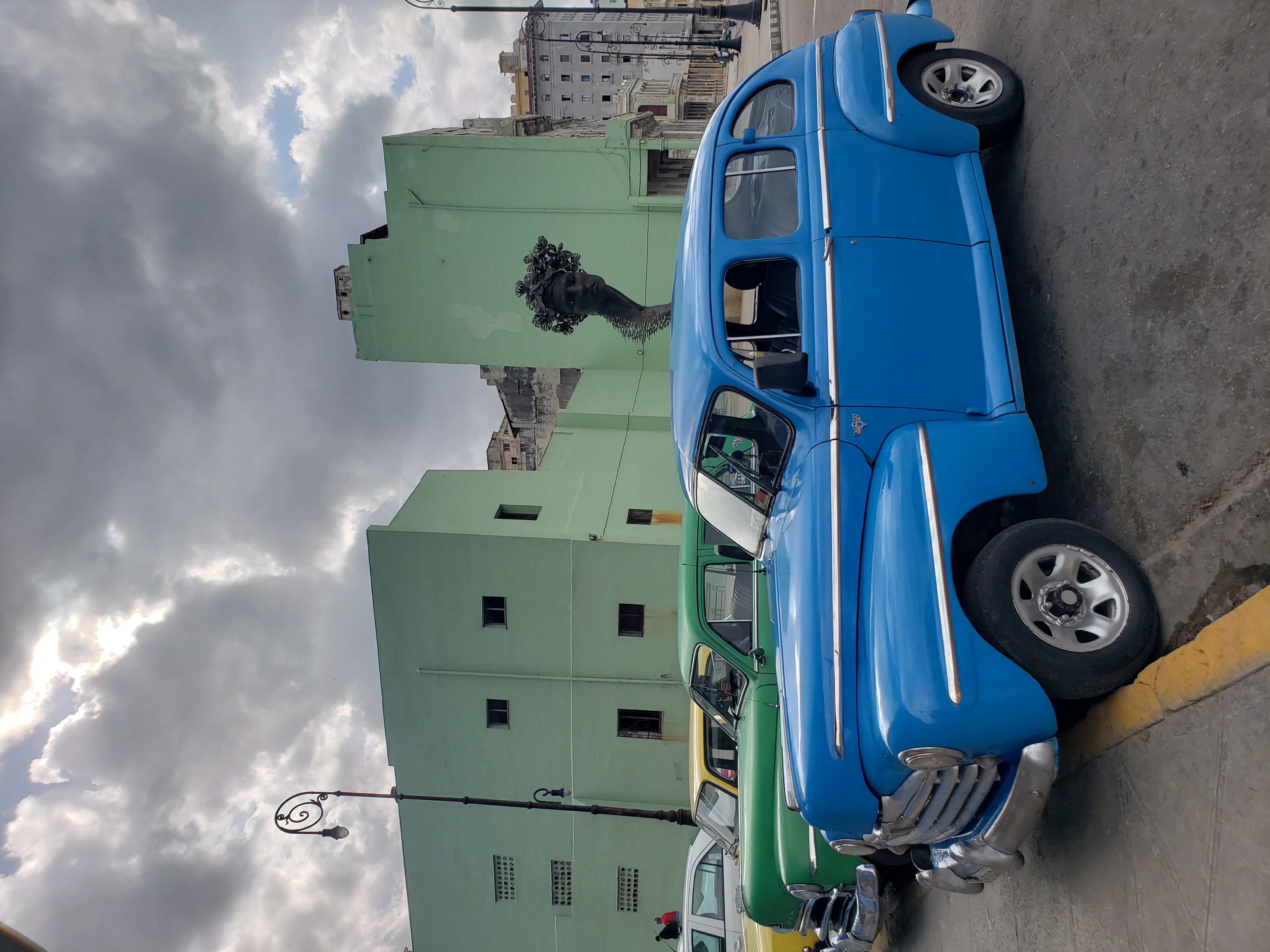
What does this mean for you as a tourist in Cuba?
In Cuba, everything comes at a price. Everything! And Cubans are not at all shy of asking for the price. I will tell you two of our experiences. (By the way, Cuban people are really nice, more on that later.)
1. Callejon de Hamel
We went to Callejon de Hamel in Havana on a Sunday afternoon. A couple of guys approached us at the entrance. Both of them and also many other people walking around wore red/white checkered shirts uniform and Callejon de Hamel identification badges. One of them was going to give us a free tour of the area. It looked official to us – you know, because of the uniforms and the badges.
This teenager was a jovial boy who walked us around the entire street and introduced us to many people, including his family and friends. “Mi amigas de la India”, he announced to everyone. With colorful art and live music all around, we had a great time watching this fusion of Afro-Cuban culture. At the end of the ‘free tour’, this guy asked for a tip. We would have anyway tipped him. But, he asked for a 20 CUC (= 20 USD) tip! While I was trying to negotiate on the tip amount (do you see the irony there?), the husband being the gentleman that he is, brought out 2 bills of 10 CUC each from his wallet. The jovial boy left the place happy. We just paid 20 USD for a free tour that we did not even book! We left feeling sweet and sour!
2. Couple photographs inside the museum
Photography is not prohibited in most of the museums in Cuba. While we were busy watching the artifacts and photographing some, the security guard approached us offering to click our couple pictures. And she did not stop at one. With my mobile in hand, the security guard made us stand in different corners and kept clicking several couple photos of ours. By then we had learnt. We knew what was going on! Thankfully, the choice of tip amount was left to us this time. This occurred in many of the museums that we visited in Havana.
However, please do not get bogged down by these kind of experiences. Instead, try to perceive the complexity of their economy before you go on your first trip to Cuba.

Personal safety
Starting to feel grim about Cuba? Please don’t! I promise, now onward, this post just gets happier.
How about personal safety in Cuba? Cuba is a country that has a revolutionary past and is still struggling with its economy. Thus, it is normal for you to have concerns about personal safety before your first trip to Cuba. But I have news for you!
Cuba is safe, very safe! Of course, you need to practice precaution and common sense as you would in your neighborhood. But apart from tourist scams or pickpockets, you do not really need to bother about any other crime. In fact, people say, the probability of someone pick-pocketing you in Cuba is lower compared to that in London, Paris or New York. Gun-crimes and murders are almost unheard of.
We had walked around all over Havana, Trinidad and Varadero on our own. All day and evening, even well past midnight. We did not ever feel threatened about our safety. Not even on the night when we had to walk in the dark in heavy rains because the power went out for the entire city due to the strongest tornado that had hit Cuba in decades.

Cuban People
I have mentioned before that Cuban people are nice. Everyone you meet will talk to you nicely. Random people on the street will stop to greet you with zestful hellos and cheerful smiles. Sometimes they will try to sell you something, sometimes they will not. Sometimes they will give you recommendations on where you can eat, without you even asking for it. They probably will earn a commission from that, they probably won’t. Whatever, wherever and however your interaction is with the local people, be sure that it will be bundled with a lot of warmth.
We once asked a policeman for the direction to a restaurant we wanted to eat at. Instead of trying to explain the way in Spanish/ broken English, he walked us to the restaurant through several lanes and by-lanes, about 1.5 km away!
Cuban people are also well-read. On learning that we are from India, a waiter at a sunset bar asked us: “Do you really have tigers in the Kumaon region of India? I read about it in a book by Jim Corbett.” If you are an Indian reading this, can you imagine our astonishment at the moment?
Talking about India, Cubans seem to be knowledgeable about people from different countries. When greeted by random strangers on the street, many of our conversations started like this (sometimes in English, sometimes in Spanish, often mixed):
Random stranger: Hello, are you from India? [That’s a first. Usually people assume us to be from some other Latin American country, more often Mexico (even in Mexico)!]
Us: Hello. Yes, we are from India.
Random stranger: Is this your first trip to Cuba?
Us: Yes, this is our first trip to Cuba.
Random stranger: Welcome to Cuba my friends. Do you like it here?
Us: Thank you. Yes, from whatever we have experienced so far, we love Cuba!
Random stranger: Ok, so you are Indians. But do you actually live in India?
Us: What makes you ask that?
Random stranger: We see a lot of Indian visitors in Cuba. But none of them actually live in India. They live in Canada, UK or US. So, where do you live? Canada?
Us: No, we live in Costa Rica.
Random stranger: Oh, you live in Costa Rica! Pura Vida!
Us: Pura Vida!
Rum and Cigar
Cuba has the best mojitos. Period.
I love drinking, socially. Rum never features among my top favorite spirits though. Also, most often cocktails disappoint me because the real spirit gets diluted in sugar rush. However, during our trip to Cuba, my first choice of poison was always rum, in some form of cocktail – mojito or daiquiri or Cuba libre. Other than the beer, of course. (Because we have to try the national beer when you are visiting a country in the Latin America or Caribbean for the first time).
Coming back to rum. What? Blame the beer for the digression.
Cocktails are really good in Cuba, made with the finest of rum. So, when you are in Cuba, you can expect to gulp down liters of rum, in the form of your preference. Oh, did I mention that it is cheap? How about $3 for a glass of mojito? (Prices can vary by bars, but you could consider $3 as the median price).
Also, make sure you pick up some Cuban cigar during your first trip to Cuba.
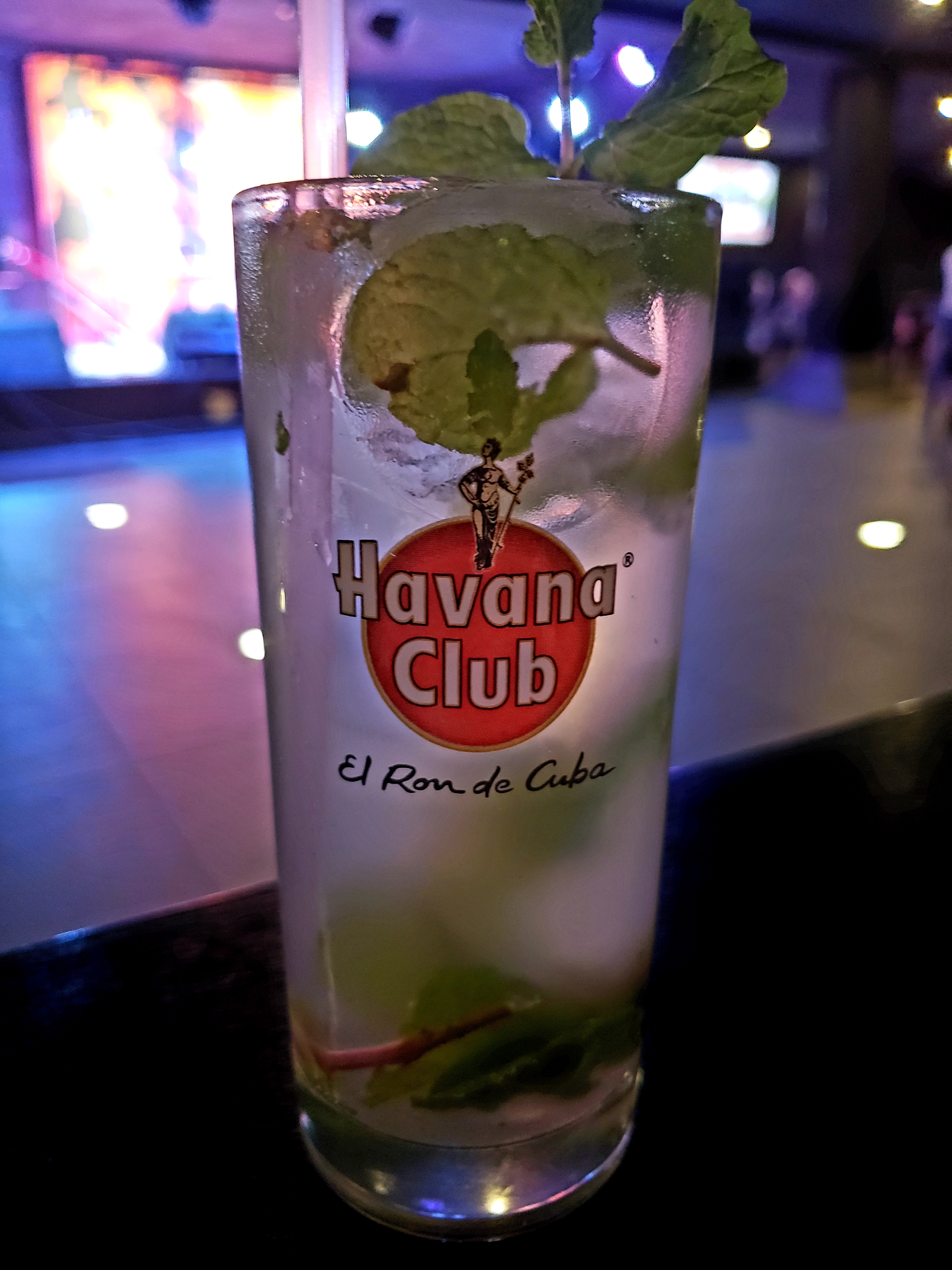
Music and dance
You are probably familiar with Cuban music and dance – from movies and music videos. Well, if you are not, listen to some right now, whether or not you are currently planning your first trip to Cuba. There must be some reason why Cuban music is hailed as one of the richest forms of regional music.
The music is a blend of African and Spanish. The instruments are unique, often hand-carved. And the dance is primarily salsa and rumba. Add to this, the passion of the performers. What is not there to love about Cuban music and dance?
There are several hotels and bars where you can pay to watch some live music. However, no need to get dismayed if you prefer to travel on budget. When you are in Cuba, you are never too far away from some Cuban live music. You will find live music everywhere – the restaurant that you went to for dinner, the bar you went to for happy hours or even on the streets while just walking by. And often you will find yourself grooving to the rhythm, like others in the crowd.
I felt the happiest when I watched the Cubans perform their music and dance. Because I observed a glow in their eyes and a big grin on their faces when they were performing. Who could tell the wrestle the country goes through when you see such happy faces? Is this what it looks like when people follow their passion?
History of Cuba
Okay, we talked so much about the history of Cuba. So, if you are planning your first trip to Cuba, of course history will feature high on your agenda! With such a striking past, no wonder the country is filled with many museums. These museums tell you tales. Tales of victory and tales of pain. Old Havana in particular is like a history book. The withering buildings may make for a good contrast for photos of you in your colorful designer dress. But if you try to read beyond what the eyes meet, they will whisper into your ears what bewildering times they have stood witness to.

Nature in Cuba
Yes, Cuba is brimming with history, politics and culture. But you will be mistaken if you discount the the geography. Cuba is the largest island country in the Caribbean. Naturally, it is lined by several stunning beaches. Plenty of smaller islands surround the mainland. The mainland, although primarily consists of flat lands, also boasts of mountains, natural reserves and karstic depressions. So, when you design your itinerary for your first trip to Cuba, make sure you pack in some elements of nature as well.

First trip to Cuba – Other details
Now that you have got an idea about what to expect from your first trip to Cuba, have you already started planning that trip? Okay then! Here are some other details you need to pay attention to, during your planning phase.
Entry requirements
You need to buy the Tourist Card at the airport before the last leg of your international air travel. The price is $99 if departing from US or $20-$30 from airports of other countries. Our final leg of air travel was from Panama City. There, the tourist card cost us $20 per person. We just needed to show our passports and boarding cards. Nothing else. Yes, even on Indian passports. Travelers from US: Please make sure you check your entry requirements separately. Example, Americans need to opt for one of the 12 reasons which allow them to travel to Cuba legally. ‘Support for the Cuban people’ is the most common one tourists choose, in case you are wondering.
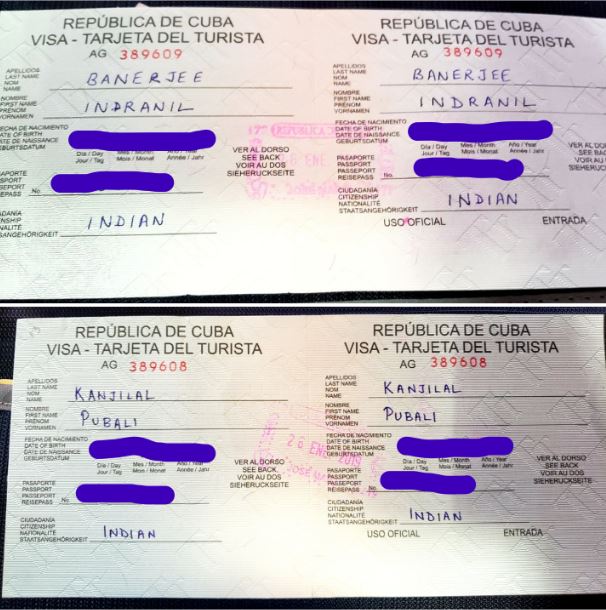
Language
While some people do speak English, it is better to brush up on some basic Spanish before your first trip to Cuba or any other Latin American country. Basic conversational Spanish makes it easier to get by, and you also can enjoy real conversations with local people.
Accommodation
While you can choose from hotels and AirBnBs, do consider staying in Casa Particulares. These are homes of local people who have opened their doors to tourists after the Cuban government introduced this option of income for their citizens. You can choose between complete privacy or staying with the owners. The benefits of staying in Casa Particulares are three-fold: (1) You get to interact with the locals everyday. (2) The prices are much cheaper compared to hotels. (3) This helps the local families generate income. Win-win, isn’t it? For a feel of how this works, check out this post on the best casa particulares in Havana, recommended by a local-expat couple.
Food
Do not expect much beyond the basics. Alas, I wish I had more to say! During our whole trip in Cuba, we had only four meals worth remembrance. First, it was at a tobacco farm in Vinales, freshly prepared home cooked lunch. Second, it was a dinner at a tavern restaurant in Trinidad. Third was dinner at a fancy restaurant at Varadero. The fourth one was breakfast at 5 esquinas in Havana. Nothing else to write home about.
Transport
Via Azul is the public bus network of Cuba which has a very good connectivity across the country. They have a fixed schedule and have comfortable coaches. We did not try the Via Azul but have read/ heard only positives about it. Except that it takes longer than a car does.
The other option for traveling between cities is taxi – private (privada) or shared (collectivo). If you are traveling in a group, hiring a private taxi will probably work out cheaper or the same as a bus ride, and of course you will reach earlier. For traveling within the cities, I recommend to use your legs. With so much character to see all around, you will not be disappointed.
You can request your Casa Particular booking agent to arrange for your taxi rides as well, whether private or shared. That is what we did. Else you can just go to the nearest bus stop to find your taxi ride or bus ride.
Final impressions
We can describe our experience of traveling to Cuba as remarkable! And we totally agree with other travelers that Cuba is a country like no other. However, for your first trip to Cuba, you need to flex your mind (and heart) to be able to comprehend what really lies beyond the postcard photos. Be prepared to get depressed, shocked and mesmerized, all at the same time!

Like the post? Pin it!
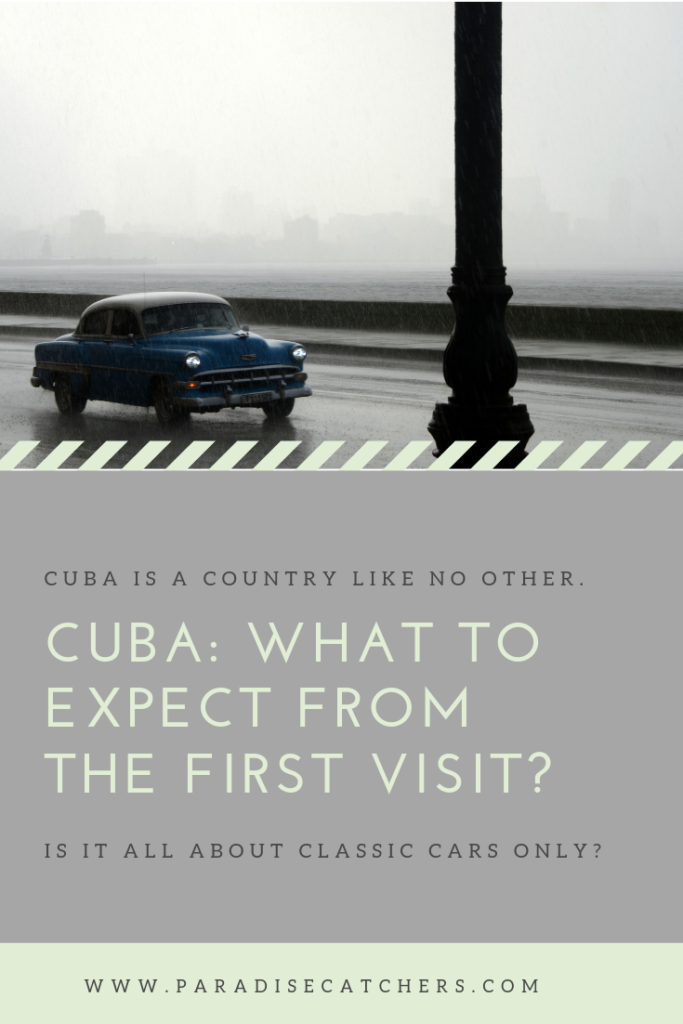
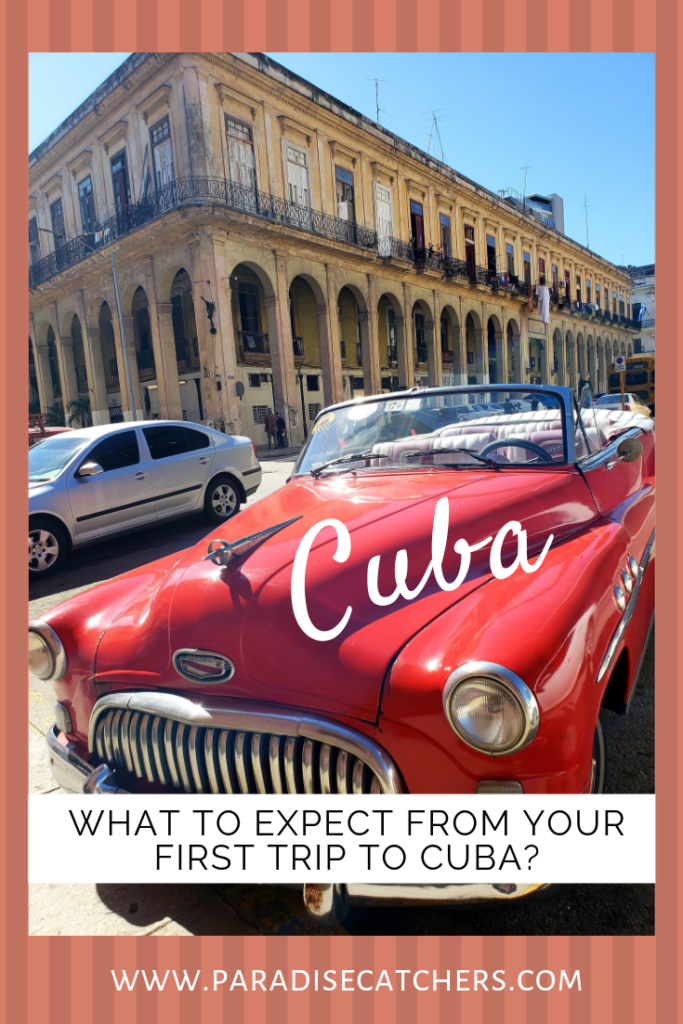
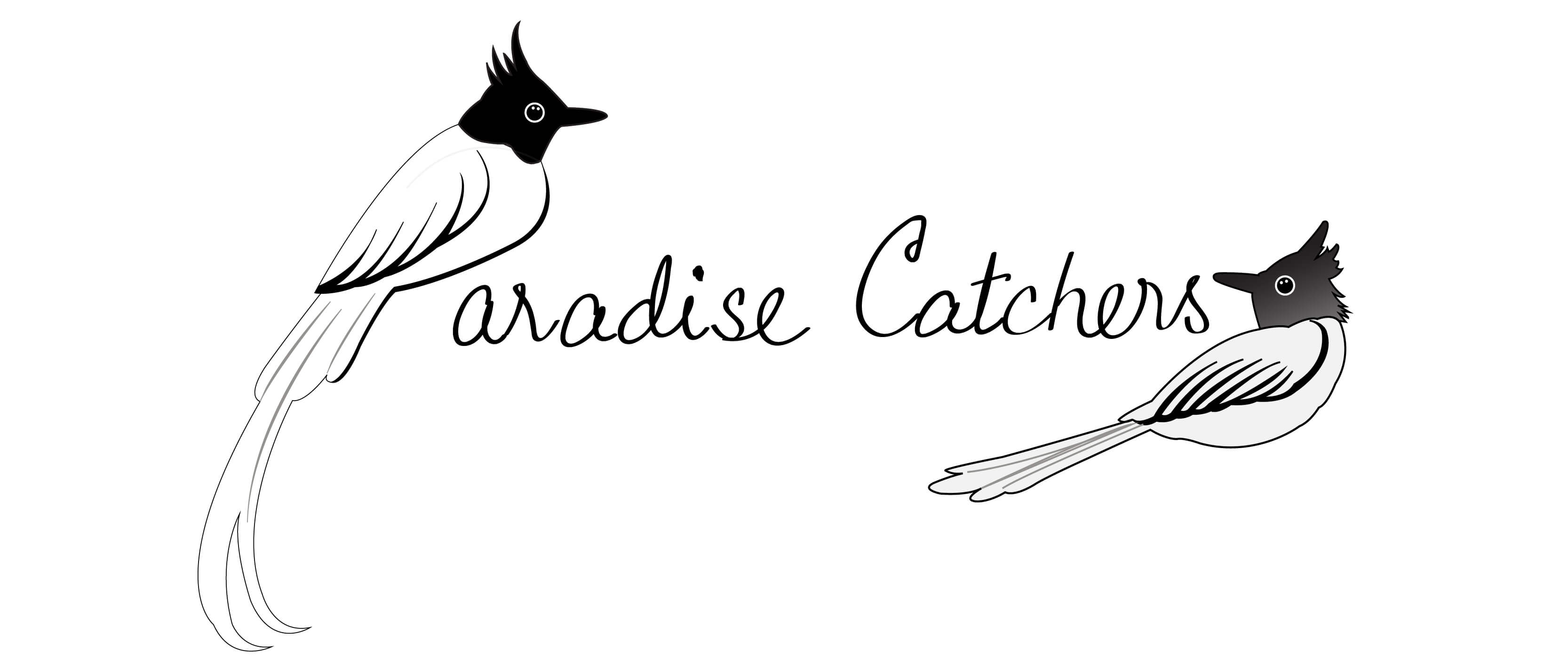
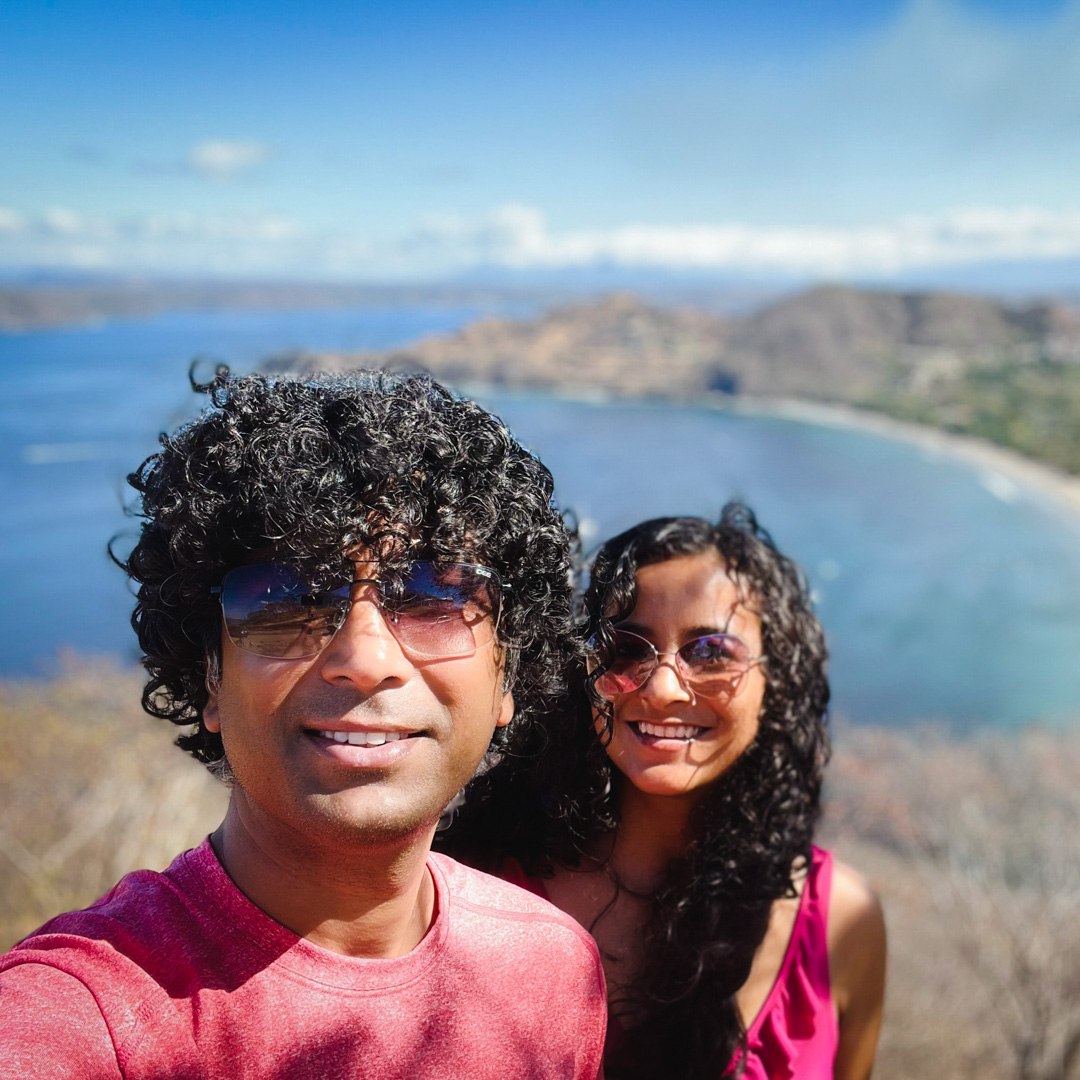
I also have heard mixed reviews about Cuba. People either seem to love it or hate it. I’ve also heard the food is terrible. Despite all of that I’d still love to go to experience the culture
Hi Kelly. Yes, please do go and discover for yourself whether you love Cuba or hate Cuba. 🙂
How fascinating! The music, dance, and history would definitely peak my interest the most! The beaches don’t hurt either! What a neat trip!
Thanks Katy. Indeed Cuba is fascinating! We are planning to write in more details about some of the beaches and the music & dance in our upcoming posts on Cuba.
What a delight to find you bring in a Bengali perspective, it was totally illuminating. I had no idea that “every Bengali considers Che Guevara an icon to idolize” I also love The Motorcycle Diaries and still felt enamored by Che after my trip to Cuba.
I think it’s a great point you made about factoring in nature, because I did a tour and this element was missing. It’s a good shout to think about it beforehand.
Hi Kelly. Glad that we were able to share a different perspective – the wonders of internet connecting the world! 🙂 Yes, history of Cuba is so strong that it can often cloud its geography, but it need not. We are planning to write in more details about the nature bit of Cuba.
What an interesting place to visit. Thanks for the advice to hopefully make travel there easier.
Thanks Brenna.
We’ve been toying with the idea of a trip to Cuba. Lots of great practical advice to help us decide and help us make the most of our time if we choose to visit! ~ Sage Scott, the Everyday Wanderer
Thanks Sage. Hope you visit soon! 🙂
Cuba is such a colorful place. I’ve heard so much about its vintage cars. I guess that’s going to be my main highlight when I go there, renting a vintage neon pink car! Haha.
Hi Akriti… Coincidentally the first vintage car we rode in Cuba was a neon pink one! 🙂
I have visited Cuba 15 times since 2009 and I’m looking forward to going there again! It’s a beautiful country, very safe, very welcoming. Unfortunately, currently its economy is in dire straits, there are shortages of everything (including gas for taxis and buses) and unless you’re staying in an all-inclusive resort, be prepared for many inconveniences.
Of course now Cuba has only one currency, CUP (the CUC was eliminated a few years ago), yet the dollar is very common. Besides, the official exchange rate is $1 = 110 pesos, whereas the informal, “street” rate is at least $1 = 250 pesos (and rising).
Yes, it’s sad that such a beautiful country is going through an economic turmoil.
When we visited Cuba, we found the dual currency system interesting. And yes, we need to update the article about the new currency system.